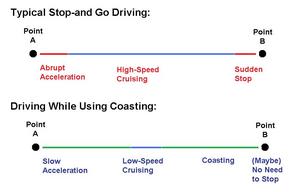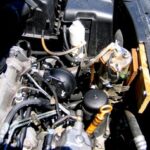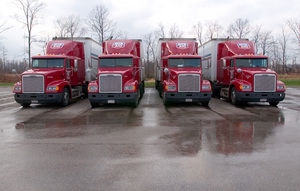Finding Ways To Save On Living Costs
As the cost of living continues to rise everywhere, folks are trying to find ways to reduce their personal operational expenses in all areas. While this article focuses on how to reduce your car or truck fuel consumption, see the end of this article for more links on how to save money on other household costs.
Some Background: Rising Fuel Costs
Of your more expensive household operational outlays for which you pay, the cost for driving and maintaining your vehicle most likely ranks near the top. As we approach the end of the peak oil era, we have seen an overall rise in the cost of everything. We are told this comes greatly as a result of rising fuel costs due to an anticipated scarcity of fuel in coming decades, as well as the overall decline in the world economy.
What does this means for us common folk? We have to pay higher fuel prices.
With this in mind, how could you reduce your car or truck fuel costs?
Saving Money With Behavior Modification
While the Internet abounds with advice on how you can reduce your automotive fuel consumption, relatively little addresses the issue of your behavior while driving your car or truck. Some articles discuss behavior changes such as not driving at all − or if driving cannot be avoided – by accelerating slowly from a stop, among other practices.
While these methods constitute sound advice, there is further opportunity which may help you reduce your vehicle’s fuel consumption.
This opportunity is called coasting.
Coasting
Coasting is simply what it sounds like − taking your foot off the pedal and allowing your vehicle run its natural course, sometimes to a full stop. While this exercise may seem somewhat trivial, once you become aware of how to leverage coasting strategically, you may realize a reduction in your vehicle’s fuel use.
While driving in town, most folks:
1. Speed up abruptly from a stop light
2. Attain some fast cruising speed, and then sharply apply the brakes to stop for the next light.
While this gets you from point A to point B well enough, it uses a relatively large amount of fuel.
As an alternative, try the following as you drive your car:
Accelerating − Depress the pedal for a painfully slow acceleration. This minimizes excess fuel consumption when speeding up.
Cruising − Maintain an overall lower cruising speed. While this requires you to hold the pedal steady, this can reduce the fuel your car consumes to combat wind resistance and the friction your tires experience when rolling on the road.
Coasting − When you see an upcoming red light from a far distance, release the pedal and allow your vehicle to coast its way towards the red light.
While the first two parts above may seem obvious, the last part (coasting) is the part about which most people forget or don’t know. While coasting may sound trivial, this kind of driving allows you to save fuel in perhaps one of two ways:
Firstly, as your vehicle coasts progressively slower while nearing the red light, you are not applying pressure to the gas pedal at all, and therefore you are only consuming enough fuel to keep the engine running. This reduced fuel consumption stands out in stark contrast to deliberately keeping the pedal depressed, and consuming much more fuel to maintain a high cruising speed.
Secondly, while your car coasts down to a slower pace, this allows the light at the intersection to run through its cycle. As you to coast down to the intersection, the light may very well turn green again and thus allow you to resume cruising again.
Why Do This?
In an ideal world, while traveling to point A to point B, you would never need to stop.
You would start the engine at point A, drive continuously at a nominal cruising speed until you got to point B, stop, and then shut off your engine. In this ideal situation, you will have avoided the two events that gobble up the most fuel: accelerating and stopping.
But because this ideal situation never shows up (especially in the city), you can leverage the fuel investment you make to get your car’s momentum going. To do this, use coasting as a means to further increase your fuel economy.
By accelerating slowly, driving at a slower overall speed, and by using coasting, you are applying an overall smoothing overstrategy to your driving behavior. By eliminating the impulsive stop-and-go pattern to your driving, you create a smooth itinerary. This constitutes the next best thing to the ideal world described above.
Coasting To The Extreme
I take my coasting to the extreme.
Because my car weighs nearly two tons, I can coast freely for extremely long distances. While the amount of energy it takes to get my car going requires some fuel investment, I can use leverage this kinetic energy to coast long distances and use no fuel at all.
To maximize the coasting concept, I lay off the accelerator whenever I can. On some flat stretches of road, this means I’m not pushing the pedal for upwards of half the drive.
See the accompanying illustration.
How To Tell If It Works
Determining whether this works for your car or truck is easy. Follow these instructions:
1. Fill your fuel tank.
2. Record the mileage on your vehicle odometer, or reset your trip odometer to zero.
3. Drive as you normally would until your fuel tank is nearly empty.
4. Fill up your fuel tank and keep the receipt.
5. Take the number of miles you’ve driven and divide this by the number of gallons it took to fill your tank the second time. The result is what your vehicle burns in miles-per-gallon.
6. Keep all this data handy.
7. Next, drive using the coasting techniques as much as possible.
8. At your next fill up, determine your MPG once again and compare it to your previous MPG calculation.
How Coasting Has Helped Me
Fortunately for me, my driving is comprised of relatively consistent and simple patterns. I use my car greatly for two purposes: to drive to work, and to go shopping and run errands. With exception to trips taking me to places I don’t know, I am familiar with the places in which I drive.
By knowing the lay of the land where you live, it will help you develop your own strategy for driving with some coasting.
All tolled, here are a couple examples of where coasting helps me:
While driving to my preferred store, I travel approximately 2-1/2 miles on flat road. During this drive, I am able to coast approximately 1/2 mile. This means I am essentially using no fuel for 20% of the trip.
While driving to work, I cover 6 miles. During this drive I can coast up to 3/4 of a mile. This means I am essentially using no fuel for 12% of the trip.
For Argument’s Sake
Some folks may rightfully argue that any savings in fuel by coasting are offset by the fuel needed to re-accelerate to cruising speed. That’s fine. But keep in mind, the main argument is that coasting helps to achieve that overall smoothingof the trip which makes for greatly reduced fuel consumption.
Smooth driving: that’s the ticket.
Limitations
As with any new idea, some limitations may apply.
If you live in a place where intersections appear within only several hundred yards of each other, you can kiss the idea of coasting goodbye. You just may not be able to let it sink in all that much. On the other hand, if the intersections to which you are driving don’t allow for a high cruising speed, you might be able to save fuel by hardly needing to press down on the gas pedal at all. Just drive slow. Cruise it like a low-rider. Try to pace your drive so that you hardly press the brake pedal at all.
If you drive in a place where driving smoothly is impractical − such as where other drivers are aggressive (think New York) – keep in mind that driving smoothly and coasting will probably make a few people become angry. Wear those earplugs so you don’t hear their horns honking at you!
Use coasting carefully. Coasting your car sometimes means driving slowly for long stretches of your trip. This kind of behavior may look suspicious to law enforcement authorities, and may subject you to being pulled over and questioned. Also keep in mind that certain roads enforce a minimum speed limit at which you can drive. Don’t get pulled over for driving too slowly.
A Variation on Coasting
If you own a stick-shift car or truck, then you may be in luck for more fuel savings.
If you coast with the clutch still engaged, your engine actually acts as a brake to help slow down your vehicle. This is bad news if saving fuel is your aim.
Instead of coasting with the clutch engaged (in gear), try shifting into neutral to take advantage of some truly “free coasting”. By doing this, you are eliminating mechanical friction from both your engine and your transmission. You will find that this form of free coasting allows your car to travel much longer distances at overall higher speeds.
Because my car has a stick-shift transmission and weighs nearly two English tons, I can free coast for really long distances.
Coast Carefully
A word of caution on this: some municipalities consider driving in neutral illegal. Check on this with your local law enforcement authorities.
As a further word of caution: owners of some older vehicles set at a low idle speed may see their engine shut down after remaining in idle for a sustained time while coasting. This happens especially during cold weather, or soon after starting up without allowing the engine to warm up. With vehicles such as these, use extreme caution with free coasting. For most cars, if the engine shuts down, there is loss of power to both the steering and braking systems.
If you own a newer vehicle with a computerized engine monitoring system, engine shutdown is usually not a concern as the onboard computer should ensure continuous and steady idling.
Try Coasting
By pushing the pedal down smoothly when accelerating, you can save on fuel. Cruising at lower speeds saves fuel, too. However, you can save even more fuel and money by incorporating coasting into your itinerary.
Sources / Further Reading:
Reduce Your Food Costs by Shopping at Local Ethnic Stores.
Make Sure to Get a Discount When Shopping Online.
Using Acetone to Increase Your Car’s Fuel Efficiency.
Using a Cold Air Intake to Boost Your Car’s Power and Efficiency.




